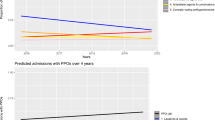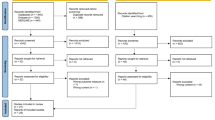Abstract
Background
Suboptimal prescribing, including the prescription of potentially inappropriate medications (PIM), is frequent in patients aged 65 years and older. PIMs are associated with adverse drug events, which may lead to hospital admissions and readmissions for the most serious cases. Several tools, known as lists of PIMs, can detect suboptimal prescription.
Objective
This systematic review aimed to identify which lists of PIMs are associated with hospital readmission of older patients.
Patients and Methods
MEDLINE, the Cochrane Library, EMBASE, and clinicaltrials.gov were searched for the period from 1 January 1991 up to 12 May 2022 to identify original studies assessing the association between PIMs and hospital readmissions or emergency department (ED) revisits within 30 days of discharge in older patients. This study is reported in accordance with the Preferred Reporting Items for Systematic Reviews and Meta-Analyses (PRISMA) 2020 Checklist, and the risk of bias was assessed with the Newcastle–Ottawa Quality Assessment Scale for Cohort Studies (NOS) and the revised Cochrane risk-of-bias tool for randomized trials (RoB 2).
Results
A total of six studies presenting four different lists of PIMs were included. Readmission rates varied from 4.3 to 25.5% and the odds ratio (OR) between PIMs and hospital readmission varied from 0.92 [95% confidence interval (CI) 0.59; 1.42] to 6.48 [95% CI 3.00; 14.00]. Only two studies found a statistically significant association between a list of PIMs and hospital readmission. These two studies used different tools: the Screening Tool of Older Person’s Prescriptions (STOPP) and the Screening Tool to Alert Doctors to Right Treatment (START) and a combination of Beers Criteria® and STOPP and START.
Conclusion
This systematic review shows that the association between list of PIMs and 30-day unplanned readmissions remains unclear and seems dependent on the PIM detection tool. Further studies are needed to clarify this association.
PROSPERO registration number CRD42021252107.



Similar content being viewed by others
References
Fried TR, O’Leary J, Towle V, Goldstein MK, Trentalange M, Martin DK. Health outcomes associated with polypharmacy in community-dwelling older adults: a systematic review. J Am Geriatr Soc. 2014;62(12):2261–72.
Thorell K, Midlöv P, Fastbom J, Halling A. Use of potentially inappropriate medication and polypharmacy in older adults: a repeated cross-sectional study. BMC Geriatr [Internet]. 19 févr 2020 [cité 4 févr 2021];20. Disponible sur: https://www.ncbi.nlm.nih.gov/pmc/articles/PMC7032002/. Accessed 4 Feb 2021.
Professeur Sylvie Legrain. Consommation médicamenteuse chez le Sujet Agé : consommation, prescription, iatrogénie et observance. Haute Autorité de Santé; 2005.
Motter FR, Fritzen JS, Hilmer SN, Paniz ÉV, Paniz VMV. Potentially inappropriate medication in the elderly: a systematic review of validated explicit criteria. Eur J Clin Pharmacol. 2018;74(6):679–700.
Beers MH, Ouslander JG, Rollingher I, Reuben DB, Brooks J, Beck JC. Explicit criteria for determining inappropriate medication use in nursing home residents. UCLA Division of Geriatric Medicine. Arch Intern Med. 1991;151(9):1825–32.
American Geriatrics Society 2012 Beers Criteria Update Expert Panel. American Geriatrics Society updated Beers Criteria for potentially inappropriate medication use in older adults. J Am Geriatr Soc. 2012;60(4):616–31.
By the American Geriatrics Society 2015 Beers Criteria Update Expert Panel. American Geriatrics Society 2015 Updated Beers Criteria for Potentially Inappropriate Medication Use in Older Adults. J Am Geriatr Soc. 2015;63(11):2227–46.
Panel B the 2019 AGSBCUE. American Geriatrics Society 2019 Updated AGS Beers Criteria® for Potentially Inappropriate Medication Use in Older Adults. J Am Geriatr Soc. 2019;67(4):674–94.
Laroche ML, Bouthier F, Merle L, Charmes JP. Médicaments potentiellement inappropriés aux personnes âgées: intérêt d’une liste adaptée à la pratique médicale française. Rev Médecine Interne. 2009;30(7):592–601.
Holt S, Schmiedl S, Thürmann PA. Potentially inappropriate medications in the elderly: the PRISCUS list. Dtsch Arzteblatt Int. 2010;107(31–32):543–51.
Gallagher P, Ryan C, Byrne S, Kennedy J, O’Mahony D. STOPP (Screening Tool of Older Person’s Prescriptions) and START (Screening Tool to Alert doctors to Right Treatment). Consensus validation. Int J Clin Pharmacol Ther. 2008;46(2):72–83.
O’Mahony D, O’Sullivan D, Byrne S, O’Connor MN, Ryan C, Gallagher P. STOPP/START criteria for potentially inappropriate prescribing in older people: version 2. Age Ageing mars. 2015;44(2):213–8.
Hanlon JT, Schmader KE, Samsa GP, Weinberger M, Uttech KM, Lewis IK, et al. A method for assessing drug therapy appropriateness. J Clin Epidemiol. 1992;45(10):1045–51.
Farhat A, Al-Hajje A, Lang PO, Csajka C. Impact of pharmaceutical interventions with STOPP/START and PIM-check in older hospitalized patients: a randomized controlled trial. Drugs Aging. 2022;39:899–910.
Laroche ML, Charmes JP, Nouaille Y, Fourrier A, Merle L. Impact of hospitalisation in an acute medical geriatric unit on potentially inappropriate medication use. Drugs Aging. 2006;23(1):49–59.
Passarelli MCG, Jacob-Filho W, Figueras A. Adverse drug reactions in an elderly hospitalised population: inappropriate prescription is a leading cause. Drugs Aging. 2005;22(9):767–77.
Redston MR, Hilmer SN, McLachlan AJ, Clough AJ, Gnjidic D. Prevalence of potentially inappropriate medication use in older inpatients with and without cognitive impairment: a systematic review. J Alzheimers Dis JAD. 2018;61(4):1639–52.
Lanièce I, Couturier P, Dramé M, Gavazzi G, Lehman S, Jolly D, et al. Incidence and main factors associated with early unplanned hospital readmission among French medical inpatients aged 75 and over admitted through emergency units. Age Ageing. 2008;37(4):416–22.
Arendts G, Fitzhardinge S, Pronk K, Donaldson M, Hutton M, Nagree Y. The impact of early emergency department allied health intervention on admission rates in older people: a non-randomized clinical study. BMC Geriatr. 2012;12:8.
Cloonan P, Wood J, Riley JB. Reducing 30-day readmissions: health literacy strategies. J Nurs Adm août. 2013;43(7–8):382–7.
Hansen LO, Young RS, Hinami K, Leung A, Williams MV. Interventions to reduce 30-day rehospitalization: a systematic review. Ann Intern Med. 2011;155(8):520–8.
Wells G, Wells G, Shea B, Shea B, O’Connell D, Peterson J, et al. The Newcastle-Ottawa Scale (NOS) for assessing the quality of nonrandomised studies in meta-analyses. In 2014 [cité 24 mars 2023]. Disponible sur: https://www.semanticscholar.org/paper/The-Newcastle-Ottawa-Scale-(NOS)-for-Assessing-the-Wells-Wells/c293fb316b6176154c3fdbb8340a107d9c8c82bf. Accessed 24 Mar 2023.
Sterne JAC, Savović J, Page MJ, Elbers RG, Blencowe NS, Boutron I, et al. RoB 2: a revised tool for assessing risk of bias in randomised trials. BMJ. 2019;366:l4898.
GRADE Working Group. GRADE Handbook. 2013.
Komagamine J, Yabuki T, Kobayashi M. Association between potentially inappropriate medications at discharge and unplanned readmissions among hospitalised elderly patients at a single centre in Japan: a prospective observational study. BMJ Open. 2019;9(11): e032574.
Chiu P, Lee A, See T, Chan F. Outcomes of a pharmacist-led medication review programme for hospitalised elderly patients. Hong Kong Med J Xianggang Yi Xue Za Zhi. 2018;24(2):98–106.
Lau MHM, Tenney JW. Evaluation of drug-disease interactions and their association with unplanned hospital readmission utilizing STOPP Version 2 criteria. Geriatrics. 2017;2(4):33.
Basnet S, Zhang M, Lesser M, Wolf-Klein G, Qiu G, Williams M, et al. Thirty-day hospital readmission rate amongst older adults correlates with an increased number of medications, but not with Beers medications. Geriatr Gerontol Int. 2018;18(10):1513–8.
Weir DL, Lee TC, McDonald EG, Motulsky A, Abrahamowicz M, Morgan S, et al. Both new and chronic potentially inappropriate medications continued at hospital discharge are associated with increased risk of adverse events. J Am Geriatr Soc juin. 2020;68(6):1184–92.
De Vincentis A, Gallo P, Finamore P, Pedone C, Costanzo L, Pasina L, et al. Potentially inappropriate medications, drug–drug interactions, and anticholinergic burden in elderly hospitalized patients: does an association exist with post-discharge health outcomes? Drugs Aging. 2020;37(8):585–93.
McIlvennan CK, Eapen ZJ, Allen LA. Hospital Readmissions reduction program. Circulation. 2015;131(20):1796–803.
Schwab C, Hindlet P, Sabatier B, Fernandez C, Korb-Savoldelli V. Risk scores identifying elderly inpatients at risk of 30-day unplanned readmission and accident and emergency department visit: a systematic review. BMJ Open. 2019;9(7): e028302.
El Morabet N, Uitvlugt EB, van den Bemt BJF, van den Bemt PMLA, Janssen MJA, Karapinar-Çarkit F. Prevalence and preventability of drug-related hospital readmissions: a systematic review. J Am Geriatr Soc. 2018;66(3):602–8.
Hekkert K, Borghans I, Cihangir S, Westert GP, Kool RB. What is the impact on the readmission ratio of taking into account readmissions to other hospitals? A cross-sectional study. BMJ Open. 2019;9(4): e025740.
Schiavo G, Forgerini M, Lucchetta RC, Silva GO, Mastroianni PDC. Cost of adverse drug events related to potentially inappropriate medication use: a systematic review. J Am Pharm Assoc JAPhA. 2022;62(5):1463-1476.e14.
Rodrigues DA, Plácido AI, Mateos-Campos R, Figueiras A, Herdeiro MT, Roque F. Effectiveness of interventions to reduce potentially inappropriate medication in older patients: a systematic review. Front Pharmacol. 2022;12:777655.
Xing XX, Zhu C, Liang HY, Wang K, Chu YQ, Zhao LB, et al. Associations between potentially inappropriate medications and adverse health outcomes in the elderly: a systematic review and meta-analysis. Ann Pharmacother. 2019;53(10):1005–19.
Unplanned hospital visits [Internet]. [cité 22 sept 2020]. Disponible sur: https://www.medicare.gov/hospitalcompare/Data/Hospital-returns.html. Accessed 22 Sept 2020.
Acknowledgments
The authors would like to acknowledge Stella Ghouti for the correction of the manuscript.
Author information
Authors and Affiliations
Corresponding author
Ethics declarations
Funding
Not applicable.
Conflicts of interest:
None to declare.
Availability of Data and Material
Not applicable.
Ethics Approval
Not applicable.
Consent to Participate
Not applicable.
Code Availability
Not applicable.
Author Contributions
Substantial contributions to conception and design, or acquisition of data, or analysis and interpretation of data: Camille Schwab, Alice Clementz, Patrick Hindlet, and Agnès Dechartres. Drafting the article or revising it critically for important intellectual content: Camille Schwab, Alice Clementz, Patrick Hindlet, and Christine Fernandez. Final approval of the version to be published: Agnès Dechartres, Christine Fernandez, and Patrick Hindlet. Sponsor’s role: none. All authors have read and approved the final version of the manuscript, and agree to be accountable for the work.
Supplementary Information
Below is the link to the electronic supplementary material.
Rights and permissions
Springer Nature or its licensor (e.g. a society or other partner) holds exclusive rights to this article under a publishing agreement with the author(s) or other rightsholder(s); author self-archiving of the accepted manuscript version of this article is solely governed by the terms of such publishing agreement and applicable law.
About this article
Cite this article
Schwab, C., Clementz, A., Dechartres, A. et al. Are Lists of Potentially Inappropriate Medications Associated with Hospital Readmissions? A Systematic Review. Drugs Aging 41, 209–218 (2024). https://doi.org/10.1007/s40266-024-01099-9
Accepted:
Published:
Issue Date:
DOI: https://doi.org/10.1007/s40266-024-01099-9




